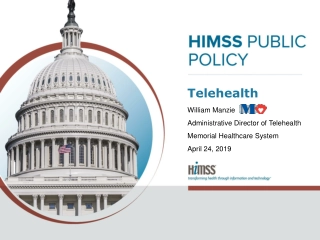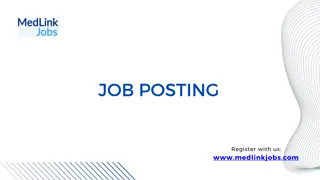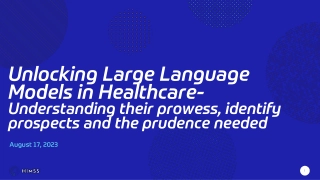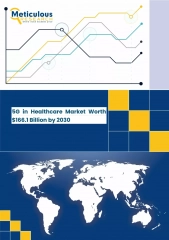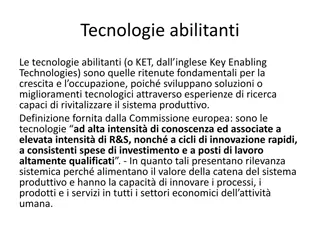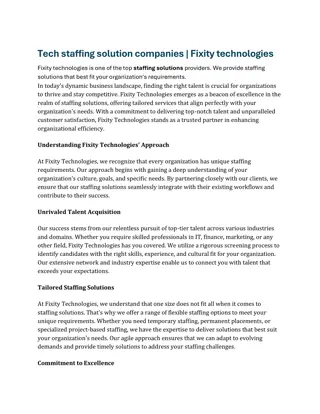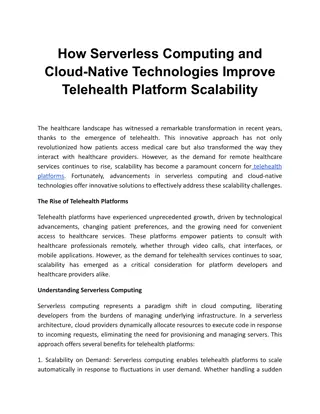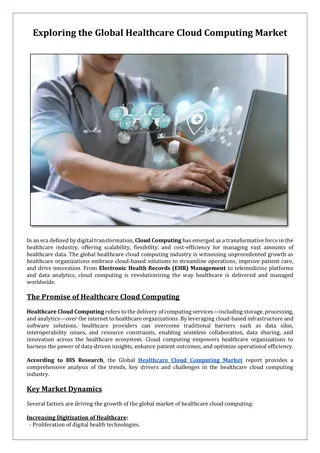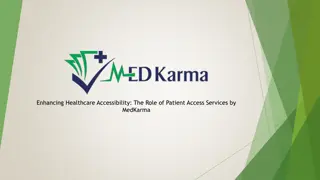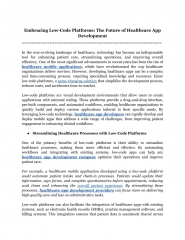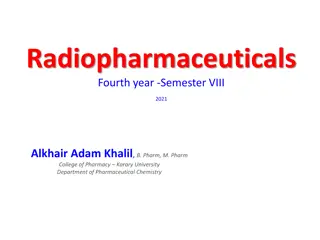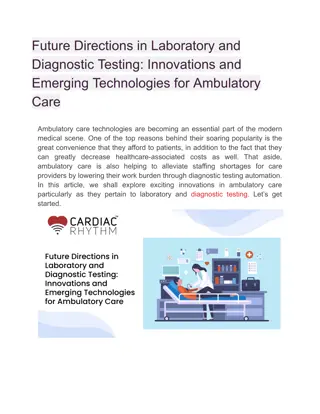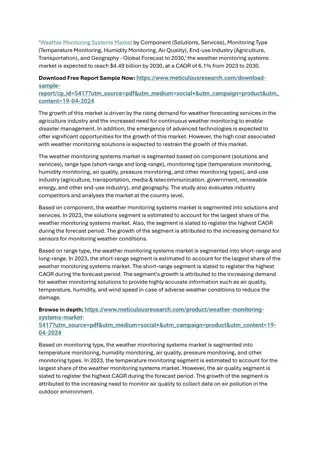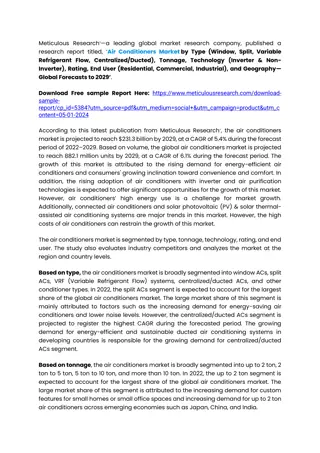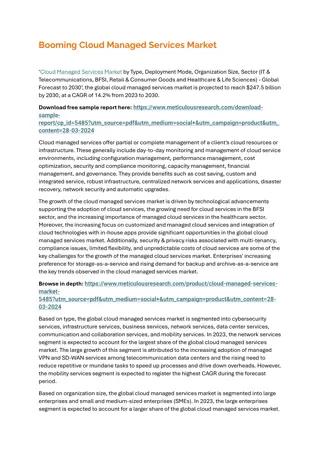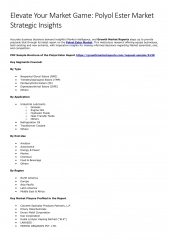Evolution of AI and ML Technologies in US Healthcare Market
Artificial intelligence (AI) and machine learning (ML) technologies are rapidly growing and evolving within the US healthcare market. These tools have the potential to revolutionize healthcare by quickly diagnosing patients, deriving new insights for treatments, monitoring patients, and streamlining non-clinical processes. Despite their benefits, regulatory frameworks like FDA guidance are still evolving to adapt to the complexities of AI and ML systems. Radiology stands out as a leader in leveraging AI/ML devices for improved diagnoses and patient outcomes.
Evolution of AI and ML Technologies in US Healthcare Market
PowerPoint presentation about 'Evolution of AI and ML Technologies in US Healthcare Market'. This presentation describes the topic on Artificial intelligence (AI) and machine learning (ML) technologies are rapidly growing and evolving within the US healthcare market. These tools have the potential to revolutionize healthcare by quickly diagnosing patients, deriving new insights for treatments, monitoring patients, and streamlining non-clinical processes. Despite their benefits, regulatory frameworks like FDA guidance are still evolving to adapt to the complexities of AI and ML systems. Radiology stands out as a leader in leveraging AI/ML devices for improved diagnoses and patient outcomes.. Download this presentation absolutely free.
Presentation Transcript
AAO Environmental & Technology Scan Artificial Intelligence September 2023 Campfire Consulting Group
Developments in Artificial Intelligence and Impacts on Orthodontics 2 2
Artificial intelligence (AI) and machine learning (ML) technologies are not only growing but also evolving in the US healthcare market. These tools have the potential to impact and transform health care by: 1. Quickly detect anomalous patterns in data or images to more quickly diagnose patients 2. Deriving new insights for both prognoses and treatments 3. Monitoring patients through a care journey 4. Streamlining many non-clinical office processes and patient interactions, such as scheduling The clinical and non- clinical uses of AI and ML in the US healthcare system is growing rapidly with far-reaching impacts and potential. These technologies leverage software algorithms to learn from real- world applications; in some instances, the algorithms may evolve to improve over time. However, AI and ML systems may have limitations due to their complexity and the innate iterative features. 3
FDA guidance for AI/ML systems continue to evolve; state regulatory guidance is still under development The current FDA approval process for medical device regulation is not designed for adaptive AI and ML technologies. Under the FDA s current approach to software modifications to medical devices, the agency anticipates that many of AI and ML software changes will need some type of premarket review, such as a 510 (k) clearance, De Novo approval or premarket approval. In the fall of 2022, the FDA Center for Devices and Radiological Health (CDRH) said that it was considering a total product lifecycle-based regulatory framework for these technologies that would allow for modifications to be made from real-world learning and adaptation, while ensuring that the safety and effectiveness of the software as a medical device are maintained. State-level regulations are still very much in development with no concrete guidance yet promulgated. State regulators and legislators may be waiting for further guidance from the federal level. 4 4
Trends in AI/ML utilization and Radiology as a leader in leveraging AL/ML devices An analysis by Rock Health Consulting of AI/ML devices cleared or approved by the FDA to be marketed in the US. technologies shows that Radiology is the most common specialty for these devices, followed by Cardiovascular, Hematology and Neurology specialties. These four specialties make up 90% of the FBD approvals, while all other specialties combined are only 10%. FDA Approved Medical Devices enabled with AI/ML 1997-2021 10% Radiologists were early adopters of AI/ML devices and have quickly leveraged the technology since there is a substantial amount of information in imaging that can be used to rapidly train the AI algorithms. Once established, AI enabled devices can precisely analyze medical images, detecting subtle patterns or abnormalities that might be missed by human radiologists. This can lead to earlier and more accurate diagnoses, improving patient outcomes. 4% 4% 12% 70% Cardiologists have found similar benefits in the utilization of AI/ML devices, especially around image analysis. Cardiologists are also utilizing AI/ML devices for remote monitoring, including early detection of abnormalities or irregular patterns. AI algorithms used in cardiology can be trained to absorb a vast amount of disparate information (e.g., test results, medical histories, information from wearable devices, etc.) in order to support both diagnoses and treatment plans. Radiology Cardiovascular Hematology Neurology All other specialties 5 5
AI/ML utilization opportunities in Dentistry and Orthodontics AI/ML device utilization in dentistry and, more specifically, orthodontics is currently limited to a few key areas. While small today in terms of adoption and usage, these areas have the potential to grow significantly over the next 5-10 years. A January 2021 review in the Journal of Dental Sciences, published states, AI models have been used in detection and diagnosis of dental caries, vertical root fractures, apical lesions, salivary gland diseases, maxillary sinusitis, maxillofacial cysts, cervical lymph nodes metastasis, osteoporosis, cancerous lesions, alveolar bone loss, predicting orthodontic extractions, need for orthodontic treatments, cephalometric analysis, age and gender determination. The article goes on to explain that accuracy of AI-derived tools for dentistry is impressive so far. They mimic the precision and accuracy of trained specialists. In some studies, it was found that these systems were even able to outmatch dental specialists in terms of performance and accuracy. Currently, image analysis is one of the leading areas for AI/ML utilization in both dentistry and orthodontics. As with both radiology and cardiovascular specialties, the sheer number of images available in dentistry and orthodontics makes for a high-volume data set to train AI/ML devices and algorithms. Image analysis currently has the capability of assisting dental clinicians in the identification of potential issues that the dental clinician cannot detect, such as early-stage dental caries lesions. Potentially, this could reduce the severity of the intervention and/or restoration required. In orthodontics specifically, digital impressions, treatment plans, as well as smile design and visualization are all part of the current AI/ML orthodontic toolkit. It is anticipated that as costs for image analysis tools enabled with AI/ML continue to decline in price, more dental and orthodontic practices will acquire them for use in day-to-day practice. 6 6
Leveraging AI in orthodontic treatment monitoring, orthodontic treatment planning, and other processes Currently, AI is being leveraged in a few key orthodontic procedures, including orthodontic treatment monitoring (Dental Monitoring) and orthodontic treatment planning (e.g., tooth movement software for aligners and Digital Indirect Bonding). AI can optimize the following routine orthodontic processes: Treatment Progress Tracking: AI-powered software can analyze 3D scans and X-rays to track the progress of orthodontic treatments. It can detect subtle changes in tooth position and provide orthodontists with valuable data on how a patient's teeth are shifting over time. Treatment Planning: AI algorithms can assist orthodontists in developing treatment plans by analyzing a patient's dental records. This can help reduce the time required for treatment and improve the accuracy of results. Digital Indirect Bonding and the use of AI-aided software to calculate optimal bracket placement and forecast end-of-treatment placement of teeth. Virtual Consultations and Monitoring: AI-powered chatbots and virtual consultation tools enable patients to communicate with orthodontists remotely. Patients can ask questions, raise concerns, share progress reports and photos, and receive targeted treatment recommendations without needing to visit the orthodontist in person. Image Analysis: Across a number of medical specialties, AI has been proven to be very efficient at analyzing medical imaging and detecting areas or issues of concern. Specifically for orthodontists, AI can analyze dental images, such as intraoral and extraoral imaging, to identify issues such as overcrowding and misalignment. 7
OrthoDx: AI-based software that automates measurements for braces and more A Boston University researcher and orthodontics instructor at the School of Dental Medicine developed a novel approach to leveraging AI in routine orthodontic care. In 2019, Melih Motro and his team developed an AI-based software called OrthoDx, which is capable of pinpointing and measuring facial structures by analyzing X-ray images of the side of a person s head. What started off as a research project quickly became focused on creating something new that makes orthodontists lives easier, says Motro. Instead of spending time using X-ray images to map out key dimensions of the face and head by locating certain anatomical landmarks of facial structures, Motro s team developed software to learn from X-rays and recognize the facial structures in the image. It then automatically assigns those key landmark points on a patient s face. Using the software, orthodontists still have full control of the measurements and landmarks and can customize measurements to a patient s needs but will no longer have to map them out manually. 8 8
Integration of AI with clinicians While AI has a clear role as a support function, it cannot replace the individual care and treatment provided by a clinician. AI/ML enabled devices and algorithms can supplement and make some elements of the treatment process more efficient, but they are not able to supplant the clinician. 9
Additionally, non-clinical use of AI is delivering a positive impact on healthcare Uses for AI in non-clinical settings is delivering a huge financial impact to the US healthcare system. A recent report from Harvard University and McKinsey estimated that AI-driven solutions could save between 5-10% of annual spending on healthcare in the US, which amounts to $200-360 B per year. However, to achieve those savings, AI implementation would need to be at a much broader scale than seen today. The big winners, at least at first, would be hospitals/hospital systems and insurance carriers. That said, more localized AI implementation has the power to make patient/clinician interactions more efficient, and to drive smoother operations within practices for non-clinical tasks, such as billing and scheduling. AI functions that can assist smaller practices include: - Automated appointment scheduling to optimize both the patient s needs as well as the available staff/time required for the appointment - Contacting patients to remind them of upcoming appointments or the need to schedule an appointment (and if a patient indicates day/time preferences, indicating the next window available for them that fits their preferences) - Intelligent document processing (IDP) to extract key information/data from a variety of inputs, including notes, test/lab results, records from other clinicians, etc. and inputting them into the patient s EMR - Further evolution of chart notes through voice recognition dictation such that the notes are standardized into a structured output (regardless of how they were read into the system) and prompts for any missing information Other tasks, such as development of website content or staff training materials are already leveraging AI-enabled tools such as ChatGPT. While outputs can be somewhat hit or miss depending on the complexity of the need, these tools can at least provide a document structure or first draft; from there, it may be much quicker to finalize the output required. 10
Patients are generally optimistic about the role of AI in healthcare but with some reservations Overall, patients in the U.S. were mostly positive about the role of AI in the current healthcare landscape according to a 2022 study by the Yale School of Medicine/Yale Cancer Center. Many respondents across age groups and ethnicities expressed that that they believed AI could improve care. Of the 926 surveyed patients: Most patients believed that AI would make health care much better (10.9%) or somewhat better (44.5%). 66% of respondents deemed AI very important in their diagnosis or treatment and 29.8% stated AI was somewhat important. However, most respondents were very concerned or somewhat concerned about AI s unintended consequences. The most- cited unintended consequences included: Misdiagnosis (cited by 91.5% of respondents as a concern) Privacy breaches (cited by 70.8%) Less time with clinicians (69.6%) Higher health care costs (68.4%) Additional findings from the study were published in the JAMA Network Open publication in May, 2022. Those findings showed that if patients were informed that AI played a large roll in their diagnosis or treatment: 66% of respondents deemed AI very important and 29.8% stated it was somewhat important. 31% percent of respondents reported being very uncomfortable and 40.5% were somewhat uncomfortable with receiving a diagnosis from an AI algorithm that was accurate 90% of the time but incapable of explaining its rationale. Responses were similar by age and race and ethnicity. 11
However, AI raises significant ethical considerations many of which are currently under debate across industries AI and AI-enabled software has been shown that it has the power to drive efficient workflows and increase outputs. The algorithms that drive AI aren t foolproof, though, and already some substantial ethical issues have emerged. In June, 2023, New York federal Judge P. Kevin Castel fined two attorneys, Peter LoDuca and Steven Schwartz, as he found that they abandoned their responsibilities when they submitted a legal brief written not by the attorneys, but by A.I. The brief in their client s lawsuit against the Avianca airline corporation cited non-existent opinions. The attorneys then continued to stand by the fake opinions after judicial orders called their existence into question according to Judge Castel. Castel ordered both LoDuca and Schwartz, along with their law firm Levidow, Levidow & Oberman, to each pay $5,000 in fines. He also ordered them to notify each judge falsely identified as the author of the bogus case rulings cited in their brief. In July, 2023, U.S. healthcare insurance giant Cigna was named as a defendant in a federal lawsuit over its use of AI in insurance claims decisions. The lawsuit, filed in the U.S. District Court for the Eastern District of California, alleges that Cigna used an AI algorithm called PXDX to screen thousands of claims for treatments that didn t match certain pre-set criteria, after which its doctors would deny the claims without individually reviewing them. By so doing, the suit charges, Cigna denied it's 2.1 million California policyholders the thorough, individualized physician review of claims guaranteed to them by California law and the payments for necessary medical procedures owed to them under Cigna s health insurance policies. More than 300,000 Cigna patient claims in the state of California may have been improperly rejected, according to the allegations detailed in the lawsuit. While these recent ethical shortfalls are quite different in terms of scope and impact, they highlight the potential misuses and shortfalls of an unbridled approach to leveraging AI. 12
Outlook for AI/ML devices and algorithms and orthodontic practices While orthodontic practices have not yet widely employed AI/ML devices and algorithms, it is almost certain higher levels of adoption will be realized over the next 5-10 years. However, the impact of AI/ML devices and algorithms on orthodontic practices will be largely dependent on a few key factors: Clear applications for orthodontics specifically (rather than a one-off modification based on another specialty) Price for adoption and financing options (leasing, lease-to-buy, etc.) Ease of use and additional training or certification required Trust in the output (both by clinicians as well as by patients) Federal and/or state regulations of these technologies Orthodontic practitioners should continue to monitor advancements in related fields such as dentistry, and radiology since some of the uses will be similar across specialties. 13
Examples of how AI could be used in an orthodontic practice AI will be able to assist in the following orthodontic practice scenarios: A patient with multiple impacted teeth is ready for exposure and traction. What will be the most appropriate force vectors and method of exposure? Can you predict which patients opting for orthognathic surgery will have the most successful outcomes? Imagine a patient contacts your office with a question and they are answered by an AI generated version of you answering their question in video delivered through a chat feature or in a response that is automatically sent to the patient via text. 14
Appendix Common AI terms and definitions References and sources Campfire Consulting Group background
Common AI terms and definitions Algorithm: A set of rules that a machine can follow to learn how to do a task. Natural language generation (NLG): This refers to the process by which a machine turns structured data into text or speech that humans can understand. Essentially, NLG is concerned with what a machine writes or says as the end part of the communication process. Artificial intelligence: The general concept of machines acting in a way that simulates or mimics human intelligence. AI can have a variety of features, such as human-like communication or decision making. Natural language processing (NLP): The umbrella term for any machine s ability to perform conversational tasks, such as recognizing what is said to it, understanding the intended meaning and responding intelligibly. Autonomous: A machine is described as autonomous if it can perform its task or tasks without needing human intervention. Bias: Assumptions made by a model that simplify the process of learning to do its assigned task. Most supervised machine learning models perform better with low bias, as these assumptions can negatively affect results. Natural language understanding (NLU): As a subset of natural language processing, natural language understanding deals with helping machines to recognize the intended meaning of language taking into account its subtle nuances and any grammatical errors. Bounding box: Commonly used in image or video tagging, this is an imaginary box drawn on visual information. The contents of the box are labeled to help a model recognize it as a distinct type of object. Pattern recognition: The distinction between pattern recognition and machine learning is often blurry, but this field is basically concerned with finding trends and patterns in data. Predictive analytics: By combining data mining and machine learning, this type of analytics is built to forecast what will happen within a given timeframe based on historical data and trends. Chatbot: A program that is designed to communicate with people through text or voice commands in a way that mimics human-to-human conversation. Deep learning: A function of artificial intelligence that imitates the human brain by learning from the way data is structured, rather than from an algorithm that s programmed to do one specific thing. Reinforcement learning: A method of teaching AI that sets a goal without specific metrics, encouraging the model to test different scenarios rather than find a single answer. Based on human feedback, the model can then manipulate the next scenario to get better results. General AI: AI that could successfully do any intellectual task that can be done by any human being. This is sometimes referred to as strong AI, although they aren t entirely equivalent terms. Supervised learning: This is a type of machine learning where structured datasets, with inputs and labels, are used to train and develop an algorithm. Unsupervised learning: This is a form of training where the algorithm is asked to make inferences from datasets that don t contain labels. These inferences are what help it to learn. Machine intelligence: An umbrella term for various types of learning algorithms, including machine learning and deep learning. Validation data: Structured like training data with an input and labels, this data is used to test a recently trained model against new data and to analyze performance, with a particular focus on checking for overfitting. Machine learning: This subset of AI is particularly focused on developing algorithms that will help machines to learn and change in response to new data, without the help of a human being. Weak AI: Also called narrow AI, this is a model that has a set range of skills and focuses on one particular set of tasks. Most AI currently in use is weak AI, unable to learn or perform tasks outside of its specialist skill set. Neural network: Also called a neural net, a neural network is a computer system designed to function like the human brain. Although researchers are still working on creating a machine model of the human brain, existing neural networks can perform many tasks involving speech, vision and board game strategy. Source: Telus International; March, 2021 16
References: Developments in Artificial Intelligence and Impacts on Orthodontics FDA clearance guidance (2022): https://www.fda.gov/medical-devices/software-medical-device-samd/artificial-intelligence-and-machine-learning-software-medical- device#regulation AI/ML utilization trends/Rock Health Advisory/Consulting (2021): https://rockhealth.com/insights/pulse-check-an-analysis-of-the-fdas-list-of-ai-and-ml-enabled-devices/ AI/ML utilization in Dentistry/Orthodontics (2021): JADA: Overview of Artificial Intelligence in Dentistry , https://436395.hs-sites.com/jadaplusai/overview-of-artificial- intelligence-in- dentistry?__hstc=25446498.b18c377569df99c03f557b1b51a2e401.1686842742561.1690577590635.1692560519150.5&__hssc=25446498.1.1692560519150&__hsfp=140522818 3 OrthoDX software (2019): Boston University The Brink publication: https://www.bu.edu/articles/2019/brace-yourselves-ai-is-coming-to-the-orthodontists-office/ Integration of AI with Clinicians: JADA: Overview of Artificial Intelligence in Dentistry , https://436395.hs-sites.com/jadaplusai/overview-of-artificial-intelligence-in- dentistry?__hstc=25446498.b18c377569df99c03f557b1b51a2e401.1686842742561.1690577590635.1692560519150.5&__hssc=25446498.1.1692560519150&__hsfp=140522818 3 Non-clinical use of AI in US Healthcare (2023): https://www.healthcaredive.com/news/artificial-intelligence-healthcare-savings-harvard-mckinsey- report/641163/#:~:text=Artificial%20intelligence%20could%20save%20the%20U.S.%20up%20to,a%20new%20report%20from%20McKinsey%20and%20Harvard%20researchers. Patients optimistic about AI (2022)/Yale Medical School: https://medicine.yale.edu/news-article/how-do-patients-feel-about-using-ai-in- healthcare/#:~:text=Using%20artificial%20intelligence%20in%20healthcare&text=While%20comfort%20level%20varied%20by,and%20increased%20costs%20were%20discussed and JAMA Network (2022): https://jamanetwork.com/journals/jamanetworkopen/fullarticle/2791851 Ethical considerations (2023): https://www.cnbc.com/2023/06/22/judge-sanctions-lawyers-whose-ai-written-filing-contained-fake-citations.html and https://abcnews.go.com/US/wireStory/cigna-health-giant-accused-improperly-rejecting-thousands-patient-101654771 17
Campfire Consulting Group Campfire Consulting Group (CCG) was founded in 2017 with offices in San Francisco, California and Denver, Colorado. 1. The partners of CCG have spent more than 25 years translating market insights into business decisions that produce quantifiable results. CCG has significant experience in the areas of forecasting/trend identification, innovation/concept development, ad testing, market/opportunity sizing, and business intelligence. The CCG approach combines proven statistical methods and research with deep human understanding to connect organizations efficiently and effectively with consumers. Alex Zuccarelli is a partner and founder of CCG. She holds a BA from Northwestern University in Evanston, Illinois and an MBA from New York University in New York, New York. In 2019, Colorado Governor John Hickenlooper appointed her to the Colorado Department of Regulatory Agencies (DORA) as a public member of the board of Chiropractic Examiners; she was reappointed to the same board by Governor Jared Polis. When her term expired, Governor Polis appointed her to the Colorado Pharmacy Board; her current appointment runs through June 2027. 18


